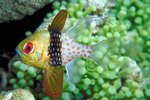
Tiger barbs are extremely popular among tropical freshwater aquarium enthusiasts. They are an excellent choice for beginners who might not adhere to a rigid water-change schedule or forget a feeding or two. Being omnivores, tiger barbs are relatively flexible regarding eating plant matter, worms and small crustaceans. Don't overfeed. They will consume whatever is offered to them, thus creating dirty water conditions more quickly.
Natural Habitat
Tiger barbs originate from Southeast Asia and are a native fish species in the waterways of Indonesia and Malaysia. They school in large numbers in streams on the Malay Peninsula and on Sumatra and Borneo islands. They prefer quiet yet fast-moving, highly oxygenated forest-area streams with temperatures ranging between 68 and 79 degrees Fahrenheit. The bottoms of their naturally preferred streams have sand and rock, supporting growth of dense vegetation.
Aquarium Needs
Even though nearly all tiger barbs available in retail settings are not caught wild but farmed, they retain the bulk of their natural preferences regarding water conditions. Freshwater aquariums should be set up to reflect these needs. These smaller fish like to swim, so, while a 15-gallon tank is adequate, a 30-gallon tank provides much more space to accommodate their natural inclination. Plant vegetation along the sides to provide hiding spaces but leave plenty of room for swimming. A 25 percent to 50 percent water change per month is the minimal recommendation to keep the closed system of an aquarium clean from phosphate buildup.
The Water Itself
Tiger barbs do not like brackish water. If you can afford it, add an oxygenation system to the aquarium setup. Doing so adds the oxygen these fish prefer to the water and provides the moderate water turbulence these fish enjoy. Tank water temperatures should range from 68 to 79 degrees Fahrenheit to mimic the temperatures of their native waters. A pH range of 6.5 to 7.5 and hardness anywhere from 2 to 30 degrees of general hardness are recommended.
Who Shares Their Water
Tiger barbs are social fish; they prefer to school in groups of six to seven individuals. They can share water space with other species of fish -- especially those that move quickly and can avoid the tiger barb's one downfall of being a bit of a tank bully, nipping at the fins of other fish. This negative behavior is somewhat controlled when tiger barbs are schooled together and not a solo representative of the species in a tank. In a group together, they tend to focus on each other rather than the other fish species in the same water.
References
Resources
Photo Credits
-
Hemera Technologies/PhotoObjects.net/Getty Images
Writer Bio
Amy M. Armstrong is a former community news journalist with more than 15 years of experience writing features and covering school districts. She has received more than 40 awards for excellence in journalism and photography. She holds a Bachelor of Arts in communications from Washington State University. Armstrong grew up on a dairy farm in western Washington and wrote agricultural news while in college.



